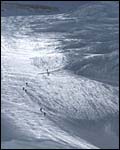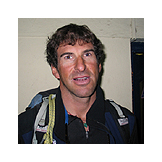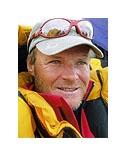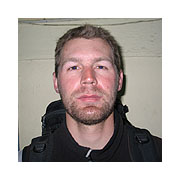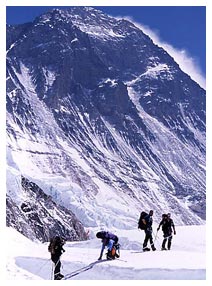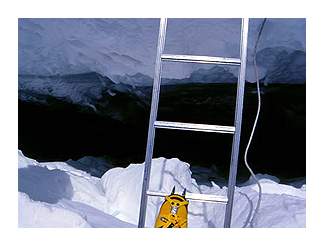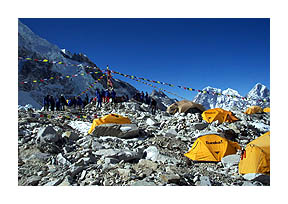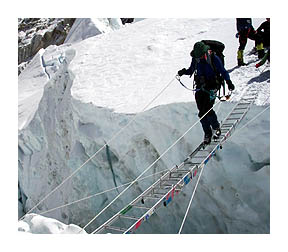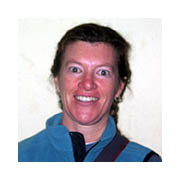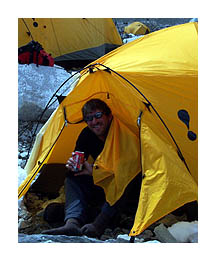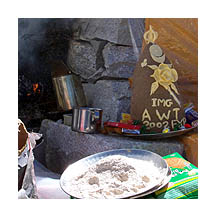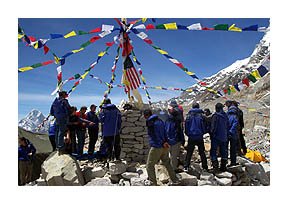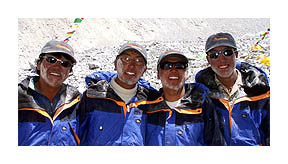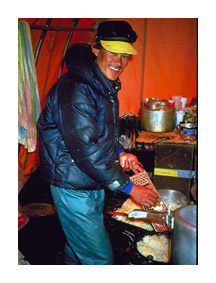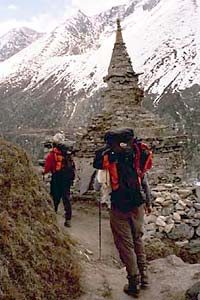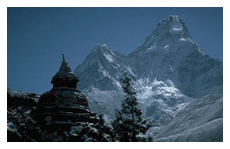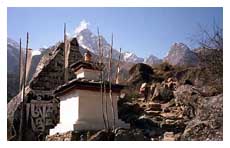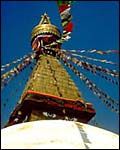2005 Everest South Side Expedition
Directed by Eric Simonson • Led by Mark Tucker
April Expedition Updates
Updates will be added as they come in from the expedition with the newest on top. April 27, 2005
|
This in turn opened the door for various team members to push up to Camp 3 to build their acclimatization and try to sleep one night at that altitude. The entire team has been rotating up and down, with Tucker busy keeping track of "who's on first, who's on second, who's on third." Tucker admits he rests a lot easier when everyone is accounted for in the relative luxury and safety of Base Camp. So, in short, the team members are now climbing in earnest, the challenge gets greater as they push ever higher, and from here on out, it will be "all business" as they get ready to think about summit bids in the coming weeks.
As promised, time to reveal the true identity of the secret agents embedded in the IMG team ranks this year. 3 members of our climbing team are professional guides working directly with some of the other climbers on the roster. We thought it would be fun to share a little bit about each of these pro climbers forming a key component of our overall group:
|
Dave Hahn has been a key figure in the annals of IMG Everest history, what else can we say? Dave Hahn began guiding big mountains in 1986, initially on Rainier and McKinley. As of Spring 2005, he'd completed 223 ascents of Rainier and 21 attempts at Denali (with 15 summits.) Experience on these two challenging mountains led Dave to begin climbing the world's 8000 meter peaks — leading, guiding and documenting IMG expeditions in the Himalaya. Dave has guided Cho Oyu's summit twice and has been to the top of Everest five times. He guided Gary Johnson (former governor of Dave's home state, New Mexico) to Everest's top in 2003 and played a prominent role in three "search" expeditions attempting to unravel the 1920's mysteries of George Mallory and Andrew Irvine on Everest. Dave has also guided for IMG in Antarctica, where he has been to the summit of Vinson 23 times (far and away the record for ascents for Antarctica's highest point.) He has also made a specialty of guiding climbing trips by ship to Antarctic shorelines like the first successful guided crossing of the "Shackleton Traverse" on the Island of South Georgia led by Dave. His home is in Taos, New Mexico where he still ski patrols and maintains his status as an avalanche professional and EMT. In 2001 Dave was awarded the Denali Pro Mountaineer of the Year by the National Park Service and the David A. Sowles award by the American Alpine Club, both recognizing Dave's heroic actions in mountain rescues. This year on the mountain, Dave is working directly with Doug Brockmeyer.
|
Walter Laserer, age 43, has been a UIAGM guide for 20 years. Walter lives in Graz, Austria, and is married with 2 daughters. His climbing resume reads like a world mountain atlas, with some interesting seasonal and adventure flair thrown in from time to time as well: Eiger northface winter, Eiger westface ski descent, El Capitan Nose, westface Husacaran and Jirishanca first flight with paraglider, Cerro Torre, McKinley winter (and many times in summer, of course), Vinson, Carstenz Pyramid, Aconcagua, Elbrus ski descent, and so the list goes on. Walter's favorite mountain area is Chamonix / Mt. Blanc, and his hobbies include swimming, mountain biking, skiing, and reading. Walter met IMG's Eric Simonson on Vinson a few years ago and has stayed in touch with IMG since then. Walter is working directly with Renate Schachinger this year on the mountain.
|
Rounding out the secret agent roster, Mike Hamill began guiding over seven years ago and has traveled and climbed on five continents. When not guiding on Rainier (where he has well over 40 summits) he can be found leading expeditions in Alaska, Argentina, Chile, Ecuador, the Himalaya (including IMG expeditions to Cho Oyu) and areas beyond. Many clients have remarked that Mike's love for the mountains is contagious. He is a former Division 1 collegiate ski racer and when not guiding, Mike is usually climbing, ski mountaineering, biking, and fly fishing his way around the globe. This year Mike arrived on Everest to work directly with climbers Wayne Morris, Jeff Strite and Jose Rionda, with an assist by Panuru Sherpa.
|
OK, expedition leader Mark Tucker is submitting quick daily dispatches to GreatOutdoors.com in case you want to check there for the up-to-the-minute news, and we'll continue these updates and send info more frequently when it looks like things really are going to start heating up on the Everest scene.
— Erin Simonson, International Mountain Guides
April 20, 2005
|
It's time for another update from Everest. In the past few days, the climbers have all done a great job of working together and laying the foundation for the hard part yet to come. Mark Tucker and Mike Dunne spent a few nice days touring up through the Icefall to check out Camp 1 and Camp 2 before returning to Base Camp. In doing so, Mike accomplished what he set out to do and will now head down the valley and back to his home in southern CA. Mark enjoyed his climbing with Mike and wished him well, sounds like they spent a lot of time day dreaming about catching good waves in the sun. It always helps to "think warm" even when you aren't!
Meanwhile, two of the summit climbers, Walter Laserer and Renate Schachinger, have been on a slightly different schedule. They arrived in Kathmandu a few days later than the rest of the summit team and have been taking things more slowly since then. They actually trekked in to Base Camp on their own and then decided to take a few days and go down to climb Lobuje Peak. They have now returned to Base Camp and will begin their cycles up the Icefall to sleep in Camps 1 and 2.
The remaining summit team members have all made a complete cycle up through the Icefall and slept at either Camp 1 or at both Camps 1 and 2. The sherpa team has been busy getting advance base camp (ABC) buffed out to become the second nerve center of the expedition during the later stages of the climb, complete with full-time cook staff and plenty of supplies for climbers staging up and down the hill, and also beginning the endless task of ferrying the O2 cylinders up from Base Camp. Base Camp itself is "almost there" now in terms of build-up for the season, although an emergency helicopter landing (big MI-17 chopper stretching absolutely to the limits of doability trying to land and take off in the thin air at BC, but fortunately the weather was as perfect as it gets and the evac was successful) yesterday demonstrated the necessity to expand the heli-pad already built by whole community using the rocks and gravel found on the Khumbu Glacier's moraine.
Conditions higher up the mountain are less than perfect right now. The Lhotse Face hosts the route from Camp 2 to Camp 3 and on to the South Col and high camp, and as of the most recent reports, conditions there are much more icy than normal, with less snowpack available for use in creating tent platforms, etc. Camp 3 on the Lhotse Face is always tight, even in the best of conditions, so it sounds like this year there may be a premium associated with decent ledges on which to perch sleeping tents.
In my next dispatch, I will spotlight some of the professional guides who are embedded in our summit team roster — with guys like Dave Hahn, Mike Hamill and Walter Laserer working within our team, we've got a lot of great experience and advice at the disposal of our climbers. We'll tell you more about them next time!
— Erin Simonson, International Mountain Guides
April 14, 2005
|
Just a quick update for now. Mark Tucker has arrived safely back at Base Camp with Michael Dunne, after completing their adventure on Island Peak and saying goodbye to Mark Wippich, Kristy Kleedehn, and Carole Shiffman, who headed downhill to make their way back to Kathmandu. Mark praised the entire Island Peak team on their stellar performance in some tough climbing conditions in the Himalaya!
Meanwhile, the climb is on for the summit team. Guide Mike Hamill has made a safe trip up to Camp 1 with Jose Rionda, Jeff Strite, Wayne Morris, Rex Pemberton, Ed Diffendal, Panuru Sherpa and Dasona Sherpa. They completed their first full climb up through the Icefall, slept at Camp 1, then made a day trip up to ABC at Camp 2 before returning to Camp 1 for another night's sleep, then back down to Base Camp to rest. The rest of the team is on a rotation to do the same thing one day later. This gradual process of moving up, sleeping for a night or two, then returning to Base Camp, will be repeated several more times by the entire summit team, each time moving up a little higher before returning to Base Camp. The repeated cycles, each time reaching a higher camp, will build their acclimatization and ready them for the eventual summit bid itself. This process requires a lot of work and patience but results in the ability to ultimately climb to the high camp, Camp 4 at the South Col, and then make a summit bid when the timing is right, the climbers feel good (relatively speaking) and the weather gods signal a green light.
Meanwhile, the climbing sherpas are making round trips each day from Base Camp to ABC and back, each time ferrying loads of gear and O2 cylinders that will be finally carried to the high camps and beyond to support the climbers up high. That's the way it works on Everest. We'll update you as the expedition builds its way up the mountain!
— Erin Simonson, International Mountain Guides
April 10, 2005 — Jet Stream Came to Town
Dear Friends and Family:
|
Trekkers Michelle Mongey and Debbie Brockmeyer headed down the valley to Pheriche, then on to Namche and Lukla, and are now back in Kathmandu, heading home. They were great members of the early team and will be missed by the expedition climbers!
Meanwhile, IMG leader Mark Tucker headed downhill to Lobuche with the Island Peak team, including Kristy Kleedehn, Carole Shiffman, Michael Dunne, Mark Wippich. Jonathan Calvert hiked downhill with them, although his plans called for a departure from the IMG team the next day when they headed up to Island Peak Base Camp and he intended to start a side trip into the Gokyo valley on his own. Mark and the group headed to Island Peak base camp (via Chukkung) to be greeted by some pretty foul weather (snow, high winds, COLD temperatures.) They hunkered down in the tents at Island Peak base camp and then pushed up to the high camp the next day, with the weather conditions still fairly unpleasant but winds calming a bit during the night and the skies clearing, giving them a tentative green light to go for a 4am start toward the summit. By the time they reached the summit ridge at well over 20,000ft. they were getting knocked around pretty hard in the wind and Mark summarized it this way: "The easy thing would have been to keep going but this sport is a bit foolish already and it seemed like we were moving toward being stupid." So, with wisdom getting the best of them, they returned to Island Peak base camp and all were very satisfied with their climb and the decision to skip the summit in favor of a better day sometime in the future.
Now, little did they know that the Jet Stream has decided to park itself right on top of the Everest region and that winds are in excess of 75 knots at the 23,000ft. level, in excess of 100 knots at the 28,000ft. level, and the only smart thing for anyone to do right now is hunker down in tents and wait it out, with winds literally ready blow you off your feet (off the whole ridge, actually) and wind chill factors well into the -30°F to -85°F range, depending on how high you are on the hill. Unfortunately, the forecasts don't show anything brewing up on the horizon that might serve to knock the Jet Stream off its current pedestal, so the waiting game begins. This is when the mental preparedness becomes critical; part of the success equation is to be able to stay psyched up and focused when weather conditions require you to spend multiple days holed up in small tents.
|
While the upper camps were being established, the summit team members took a morning spin into the Icefall last Friday to get a first hand glimpse of the route they'll follow several more times in the coming weeks. (A typical Everest summiter will usually take at least 4 or 5 round trips through the Icefall during a season.) On this first foray, some of them made it over half way up, some up to the "Popcorn Field" (about one third of the way up, it looks like a bowl of popcorn from a distance and is full of smaller blocks of ice that have broken off), and some made it over a few ladders and decided to wait for a calmer day. All had a good 'Intro to Icefall' session.
With another day or two of rest, some of the climbers had planned on heading up to sleep at Camp 1 today. But with the winds blowing as they are, everyone has now reconsidered their options and decided to stay in the relatively balmy confines of Base Camp. There's plenty of calendar left in this season, better to wait for the better day they know will come.
|
Michelle's sister Denice sends us this great introduction to Michelle: "Michelle lives in Morris Plains and has taught special education for 20 years at West Morris Central High School in NJ. Our Irish-born parents instilled in her a love for travel at a very early age. Michelle loves adventures, and has had plenty of them — following Lewis and Clark's expedition route, roughing it in the Amazon, running with the bulls in Spain, and organizing trips to Ireland for up to 30 people each year. She has travelled to all the continents except Antarctica and I am confident she will be there one day too. If Michelle has a day off you can be confident she is not sitting at home. Michelle has such a contagious energy; she is known for enticing/motivating others to join her. She's an aunt (seven times over,) a sister, a friend and an inspiration to many!"
OK, that's it for now, we'll let you know when it's safe to come out of the tents again.
— Erin Simonson, International Mountain Guides
April 5, 2005 — Basecamp Puja
|
The order of the day is .... Puja! This solemn ceremony is a memorable event and a pre-noon cocktail party, all rolled into one. It is a must-do part of any Everest expedition, and because we think it so special, we encourage our entire climbing and trekking team to witness it and participate in it, and we schedule our itineraries so everyone can. The sherpas consider it an extremely bad omen to climb above Base Camp without seeking the blessings of the mountain and making their offerings, we consider it bad form to not support them in this, and nowadays, Puja is just what you do at Base Camp when you are mounting an Everest expedition.
|
|
In the classic Tibetan manner, each person throws a pinch of tsampa into the air simultaneously, symbolizing an expression of good wishes for their own and others' happiness and last but not least, suggests all receive any and all divine help available in the overcoming of all obstacles, which becomes very important in the coming months! Rice that has been blessed may also be thrown. Now the mounds of food and drinks blessed during the ritual are quickly distributed and two things generally occur. First, the remaining unthrown tsampa is affectionately sprinkled or rubbed into the faces and hair of most participants, casting a ghost-like quality to their appearance even though the acts are purely friendly and playful in nature. Then, the beer starts getting consumed, and given the team's recent arrival at this altitude and the pre-lunch hour of the event, one fourth of a can of PBR is usually all it takes to feel fairly merry!
|
With the Puja pole in place, the prayer flags and juniper smoke in the air, everyone taking a little nap to promote their health, and the O2 inventory in great shape, it will soon be time to start thinking about climbing this mountain. Some of the team will head downhill in the next day or two to take on Island Peak, some will head downhill to return home, and some will look uphill and begin embracing their next obstacle, the Khumbu Icefall. We'll keep you updated!
— Erin Simonson, International Mountain Guides
April 4, 2005 — First Sunrise at Basecamp
|
We're happy to announce that the team is enjoying their first Base Camp sunrise! After a quick hike in marginal conditions up to the top of Kala Pattar for four of the team members, the group trekked the last stretch of trail and arrived at Base Camp ready to hit the dining hall (tent) and enjoy warm drinks, thanks to the advance planning of Pemba, our trusty expedition head cook and ace in IMG's Khumbu Kitchen. After resting, meeting the sherpa team and a great dinner together, everyone retired early to their sleeping tents to unpack and get sorted and layered up for the night.
When the team finally settled into their bags, the not-so-distant but all too constant creaks and crashes of rock and icefall from the surrounding flanks of Everest, Pumori and Nuptse became the bedtime lullaby. Eventually everyone got some much-needed shuteye.
Temperatures continued to be pretty chilly and the team was dusted with snow during their journey to Base Camp, but the morning dawned clear and sunny for them and as Mark put it, one by one "heads poked out of the tents like groundhogs" to marvel at the early light at Base Camp. Mark's call was brief, probably the smell of Pemba's special Base Camp breakfast was a call to action! He promised to call in later with a longer description of the team's status and plans for the next few days, including tomorrow's Puja ceremony, which will bring the team together in spirit and clear the way for the lead climbers to begin making their way up from Base Camp through the Icefall to begin establishing the upper camps. No one climbs until the Puja happens, though, so that's on the immediate agenda. We'll include a longer dispatch tomorrow with a complete description of the festivities as they occur.
— Erin Simonson, International Mountain Guides
April 2, 2005
|
Mark Tucker has called in a few times in the last few days. The satellite phone connections have been fairly marginal, but we've gleaned that the group has generally progressed quite well. Leaving their campsite in Deboche (near Thyangboche village), the team headed uphill to Dingboche, where they spent two nights and enjoyed a sidetrip to the HRA clinic in Pheriche. Their arrival in Dingboche also brought them up out of the forests and into the high-alpine terrain of the upper Khumbu. They were greeted by falling snow and were reminded that while spring has come to Nepal, their current elevation puts them back in 'winter mode' most of the time. A Singapore University and Mountaineers team (on logistics support by none other than IMG!) had done a warm-up on Island Peak and said "hello" as they passed the IMG team near Dingboche while making their way up to Base Camp. The two teams will be operating separately on Everest this year but will be Base Camp neighbors.
The altitude is taking its inevitable toll. A few folks have developed the "Khumbu Cough," a fairly normal annoyance. One of the team members decided to stay in the relatively luxurious air of Pheriche for an extra day and opted not to trek with the rest of the group as it moved up to Lobuche at nearly 16,000ft. He joined the team in Lobuche the next day feeling much better. The ascent to Lobuche is a "character builder" and the route includes a section of trail with stone tributes to many climbers who have gone to Everest but did not return home. For those on the team contemplating a summit bid, it is an emotionally charged experience to take a sobering walk through these memorials. News of the death of two climbers on nearby Pumori has also dampened the mood in camp, and all send their condolences and sympathy to the families and friends of those lost climbers.
Temperatures in Lobuche have reportedly been hovering around 15 degrees at night, so the evening air is quite nippy and the team has started sleeping with their water bottles tucked snugly inside their sleeping bags so they have something other than solid ice to drink in the early morning hours. During the day, the open, rocky terrain (on the terminal moraine of the Khumbu Glacier) usually warms up nicely with the morning sun and the down jackets are retired until just before sunset, when they are quickly donned again. Once the sun sets below the horizon, the air temp plummets quickly and the team members are doing a great job of "planning ahead" and getting layered up before their body loses the precious heat gathered in the daytime sun. In that setting, it becomes increasingly difficult to stay warm and very difficult to play 'catch up' if you get too cold before layering on the fleece and down.
While the team has been working its way uphill, back at home Great Escapes and IMG were scrambling to deal with another blockade of the roads in Kathmandu. All ground transportation in the country has been suspended for 10 days starting April 2nd, so we had to get the trek support squad for our Tibet trekking group loaded up and out of Kathmandu and to the Tibetan border before the blockade took effect. None of this will impact our teams up in the Khumbu as these transportation strikes and blockades have been called with fair regularity in the past with no impact in the mountains, but any climbing teams still in Kathmandu planning to head to the north side of Everest in Tibet via the roads are in a bit of a bind if they didn't get out of town by April 2nd. It appears now that the roads will all be blockaded until April 11th, which could be a serious loss of critical days for a climbing team in its early launch stages. We hope other teams don't get set too far back from this.
Despite the problems at hand, many of them very typical of an Everest season, Mark's last call from Lobuche was quite upbeat. The team looked forward to rising in the morning and taking a hike to the top of Kala Pattar at over 18,000ft. Another "character builder," the summit of this non-technical peak affords some spectacular views of Mt. Everest and Pumori and the photos from the top usually are enough reward for the effort. The team will descend and spend another night before making the final push up to Base Camp proper the next day. Mark was able to make radio contact with Base Camp and learned that the IMG yaks and loads had arrived in good time and the sherpa teams there were rapidly erecting the miniature city the teams will live in during the coming months.
So Base Camp is just a few days above and beyond them now, the team is doing great. When they get to Base Camp, they will fire up the stronger sat phone and hopefully we'll get some photos from them.
— Erin Simonson, International Mountain Guides
March 28, 2005
Dear Friends and Family:
|
|
|
Mark Tucker lives in Seattle, WA, although if you've ever seen the inside of his van, you'd think that was his home. He carries a full inventory of clothes and sporting equipment with him at all times and must live by the "Be Prepared" Scouting motto. Mark has been guiding since 1985, with Mt. Rainier as his starting point. Since then, he has climbed and guided classic peaks on all seven continents, with the summit of Mt. Everest as his high point. This year's expedition will be Mark's sixth to Everest. Mark does not plan to make a summit bid this year but will instead oversee and coordinate the many moving pieces. He'll probably take a few trips up through the Icefall to check out the scene at Advance Base Camp just for old time's sake. When not in the hills, Mark leads a fun-filled Other Life. Passions by land include mountain biking, skiing, snowboarding, motorcycle riding, and gardening (he's still working on the golf game.) By water, he enjoys surfing, kayaking, wind surfing, scuba diving, water skiing, and fishing. Suffice it to say he knows the beaches of southern California and the north shore of Maui almost as well as the trail to Everest Base Camp...
Q&A from Home: "What does 'Sherpa' mean? Is it an occupation or a title or a family or what?"
The term 'Sherpa' refers to an enire ethnic group of people descended from clans that fled eastern Tibet in the 1600's due to famine or feudal wars, ultimately settling in the mountainous regions of Nepal. Today most Sherpas live in Nepal, with some also residing in India, Bhutan and Tibet. Experts estimate that the total Sherpa population only numbers about 35,000 worldwide. In recent years, with the popularization of mountaineering in broadcast and print media, the word has become associated with the members of this ethnicity that form the backbone of climbing strength for most Everest and other Himalayan climbing expeditions.
|
Jangbu is a partner and director of Great Escapes Trekking, a premier trekking and climbing agency and trusted, long-time IMG agent in Nepal. Jangbu will assist Mark in managing the overall conduct of the expedition and his fluency in English, Nepali, and the sherpa dialect help him interface easily with the various teams and characters on the mountain each year. Jangbu grew up in the village of Phortse where he attended the Hillary school until the age of 18. In 1981 he moved to Pokhara and lived there for seven years and trained under the legendary Colonel Jimmy Roberts, founder of Nepal's first trekking company and the entire trekking industry in the Nepal Himalaya. Jangbu then moved to Kathmandu and started Great Escapes with his two other partners in the spring of 1993. Jangbu is married and has two children. He has been on dozens of expeditions, summitting Everest on the 1990 American Everest Expedition. Jangbu has climbed Europe's Mt. Blanc and most of the 14,000-foot peaks in Colorado, and has also served as assistant instructor for Colorado Outward Bound.
OK, that's about it for now. We'll keep you all posted as the progress continues!
— Erin Simonson, International Mountain Guides
March 26, 2005
|
A formal briefing with the Ministry of Toursim in Nepal is required of each expedition mounting an assault on Everest. The team leaders meet with government officials to discuss regulations associated with resource preservation, communications protocols and permit compliance. This has become somewhat of a formality for companies like IMG regularly organizing Everest expeditions, but remains a necessary step in the pre-departure process in Kathmandu. While the briefing occurred on March 23rd, the rest of the team was able to sightsee in Kathmandu and explore the city's historic palaces, temples and tourist attractions. Then, on March 24th, the entire group flew from Kathmandu to a village at the base of the Khumbu region known as Lukla. The short rural mountain airstrip (pictured here) tentatively perches at the edge of a deep canyon; arrival and departure is always something of a nailbiter. Rains during the week had prevented many teams from making their scheduled flights to Lukla, but the morning of our team's departure dawned bright and the flight went off without a hitch. The group then met the support Sherpas assigned to assist on the trek to Base Camp and hiked together to Phakding for their first overnight on the trail.
While preparations in Kathmandu were made, helicopter charters had simultaneously moved the tons of gear as high into the Khumbu Valley as possible, usually Shyangboche (pictured here), where equipment was then unloaded, repacked, and began its upward journey via yaks to Base Camp proper. An advance team of Sherpas had already been at Base Camp for over a week, nailing down a favored location and building the kitchen and tent platforms from rocks on the glacial moraine below the Icefall. They descended to Namche Bazaar at 11,300ft. on March 25th to meet the team on their second day of uphill hiking. Saturday is "market day" in Namche, a major trading center in the Khumbu region, and is a fun day to see the many Sherpa farmers congregate to exchange their weekly goods. Eggs, vegetables, cheese, meat, livestock and other products from the rural mountain villages are sold and bartered in classic fashion and the entire day provides a great insight into the everyday lives of the people populating this beautiful region. Tibetans often travel to Namche to join the exchange. The team will spend the 26th as a rest day intended to promote their acclimatization process and will enjoy the Namche Bazaar market day spectacle.
Eric Simonson joined the group's trip to Namche and will meet with the climbing Sherpas there to oversee the final gear logistics and set the stage for assignments and protocols to be followed during the rest of the program. With everything in good hands, he'll return to Kathmandu on one of the empty cargo choppers on the 26th and let Mark Tucker and Ang Jangbu Sherpa (pictured here looking down on Namche) take the leadership helm. So far, so good. Only one piece of checked baggage failed to make it to Kathmandu with the team, not bad considering by our count over 75 duffles were involved. Everyone is feeling OK, the gear is in place, prayer flags are fluttering in the light breeze, all systems are a go!
« Trip Intro • The Team • April Updates • May Updates »
©2005 International Mountain Guides; All Rights Reserved.
